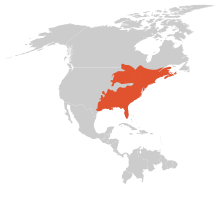Notophthalmus viridescens
| Eastern newt | |
|---|---|
 |
|
| Aquatic adult male | |
| Scientific classification | |
| Kingdom: | Animalia |
| Phylum: | Chordata |
| Class: | Amphibia |
| Order: | Urodela |
| Family: | Salamandridae |
| Genus: | Notophthalmus |
| Species: | N. viridescens |
| Binomial name | |
|
Notophthalmus viridescens (Rafinesque, 1820) |
|
 |
|
| Eastern newt range | |
The eastern newt (Notophthalmus viridescens) is a common newt of eastern North America. It frequents small lakes, ponds, and streams or near-by wet forests. The eastern newt produces tetrodotoxin which makes the species unpalatable to predatory fish and crayfish. It has a lifespan of 12 to 15 years in the wild, and may grow to five inches in length. These animals are common aquarium pets, being either collected from the wild or sold commercially. The striking bright orange juvenile stage, which is land-dwelling, is known as a red eft. Some sources blend the general name of the species and that of the red-spotted newt subspecies into eastern red-spotted newt (although there is no "western" one).
The eastern newt includes these four subspecies:
Eastern newts have three stages of life: (1) the aquatic larva or tadpole, (2) the red eft or terrestrial juvenile stage, and (3) the aquatic adult.
The larva possesses gills and does not leave the pond environment where it was hatched. Larvae are brown-green in color, and shed their gills when they transform into the red eft.
The red eft (juvenile) stage is a bright orangish-red in color, with darker red spots outlined in black. An eastern newt can have as many as 21 of these spots. The pattern of these spots differs among the subspecies. An Eastern Newt's time to get from larvae to eft is unknown. During this stage, the eft may travel far, acting as a dispersal stage from one pond to another, ensuring outcrossing in the population. The striking coloration of this stage is an example of aposematism — or "warning coloration" — which is a type of antipredator adaptation in which a "warning signal" is associated with the unprofitability of a prey item (i.e., its toxicity) to potential predators.
After two or three years, the eft finds a pond and transforms into the aquatic adult. The adult's skin is a dull olive green dorsally, with a dull yellow belly, but retains the eft's characteristic black-rimmed red spots. It develops a larger, blade-like tail and characteristically slimy skin.
...
Wikipedia

